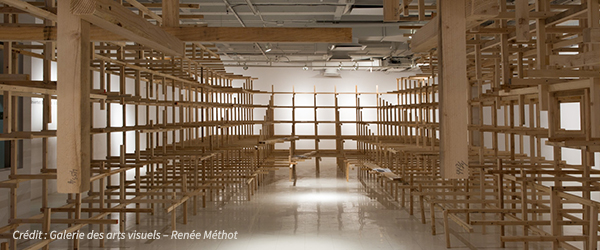

Vernissage: le 9 novembre à 17h précédé d’un échange avec l’artiste dès 16h
Du 9 novembre au 18 décembre 2016
Adrian Blackwell
Inverted Barricade (la barricade inversée)
Adrian Blackwell était parmi nous l’hiver dernier dans le cadre de notre programme de conférences Espaces publics et mobilité. Cette collaboration se poursuit et nous sommes heureux de l’accueillir de nouveau, cette fois dans le cadre d’une intervention in situ à la Galerie des arts visuels.
Abordant la forme singulière de la barricade, Adrian Blackwell poursuit sa recherche sur les espaces physiques urbains, mobilier, architecture, et les forces politico-économiques qui les traversent. La barricade, une construction spontanée utilisée historiquement contre le pouvoir de l’état, demeure selon lui une affirmation fondamentale du statut politique de la rue. Dans sa forme et son sens d’origine, elle constitue un des rares exemples de constructions purement collectives. Blackwell envahit l’espace de la Galerie des arts visuels d’une vaste construction in situ composée d’une multitudes de tiges de bois. Ce réseau complexe contraint nos déplacements et nous confronte dès l’entrée. En en faisant le tour, on découvre en son centre, tel un moule inversé, l’espace négatif, vide, d’une barricade désormais absente. Cet espace devient le lieu d’échanges et de regroupements inédits. L’artiste nous y convie tout particulièrement à l’occasion d’une rencontre-discussion sur ce thème le mercredi 9 novembre dès 16h00.
L’artiste tient à souligner le magnifique travail de l’équipe étudiante de la Galerie des arts visuels pour le montage de ce projet. Merci à Dany Massicotte, Andréanne Perron, Steven Grondin et Sophie Perron.
Adrian Blackwell est artiste, auteur et designer. De plusieurs expositions dans divers centres d’artistes et institutions au Canada, en Angleterre, aux États-Unis et en Chine, signalons: la Biennale de Shenzhen (2005), la Biennale de Chengdu (2011), Circles Describing Spheres, au Haverford College (Penn.) et à la OCAD University’s Onsite Gallery (2014), Furnishing Positions, à la Blackwood Gallery (2014), l’intervention Migrant Choir, en collaboration avec Public Studio, à la Biennale de Venise (2015), et Mirror Circles for Ba Jin, à la Shanghai Urban Space Art Season (2015). Notons quelques écrits récents: «Forms of Enclosure in the Instant Modernization of Shenzhen», Volume #39, 2013, et «What is Property?», Journal of Architectural Education, vol. 68, 2014. Il rédigeait en 2015 un essai intitulé «Not a Tribute to Liberty» dans le catalogue de l’exposition de Samuel Roy-Bois, Oakville Galleries. Il enseigne à l’École d’architecture de l’Université de Waterloo. Membre du Toronto’s Anarchist Free School et du Toronto School of Creativity and Inquiry, il a fondé le journal Scapegoat: Architecture / Landscape / Political Economy.
Conférence
Inverted Barricade
Adrian Blackwell, texte de projet, 2016
Barricade n. hastily erected rampart across street etc. of barrels, carts, stones, furniture, esp. during revolution; barrier (lit. or fig.).
The building of barricades appears in Fourier as an example of “nonsalaried but impassioned work. »
Walter Benjamin, The Arcades Project (Cambridge: Harvard University Press, 1999), 141.
A barricade is an improvised barrier, that blocks a road or passage, to slow down or arrest movement. Because of its ad hoc construction it is a tool originally used by civilians against the power of the state. In its original form and meaning, the barricade is one of the few truly collective spatial constructions. It is the carnival of architecture: many people collaborating toward a common goal, without the necessity of centralized control. It is also a form of popular of urban design or planning, allowing ordinary citizens to change the flows of people and goods within the city or countryside. The barricade is a fundamental assertion of the political nature of the street, in place of its purely functional uses. It is one of the few modifications to urban space that can be improvised by many people working independently with minimal coordination, or negotiated individually between builders.
According to Eric Hazan in A History of the Barricade, the barricade is a French invention and its most important historical manifestations have been in Paris. Famous barricades were built in Paris in February of 1848, in the commune of 1871 and in May of 1968. However, while the word may be of French origin and it was popularized in Europe in specific French revolts, the simple act of piling elements to block passage is much older than these examples, and its use has spread throughout the world. Recent examples in Canada include events associated with the Idle No More movement, such the CN blockade in Sarnia, in 2012, and barricades set up in Montreal during the Quebec Student Strike of 2012.
Of course, the meaning of the word barricade has changed over time, so that today it is also used to describe the temporary barriers are also hastily erected by authorities in order lock down areas of the city, as has been done for large supranational gatherings since the meeting of the WTO in Seattle in 1999, for instance at the 3rd Summit of the Americas in Quebec City in 2001, and the meeting of the G20 in Toronto in 2010. The barricades erected in Quebec City and Toronto, create impassable voids in the center of their respective cities. This state sanctioned barricade is nothing but one exceptional element within a larger project of spatial enclosure and fixing that is essential to the smooth functioning of the capitalist economy.
This tactic of closing the center of the city was detourned, or inverted, in the fall of 2014 in Hong Kong, during the pro-democracy movement’s “Occupy Central with Love and Peace”. In this case thousands of activists and students inspired by the force of their conviction of the importance of free elections, built expressive barricades to block access to Central Hong Kong for weeks. Inspired by the energy and enthusiasm of these activists, the barricades created a free space of occupation within the city, asserting people’s right to the city. It is important to understand this simple act of urban intervention and simple construction as a constructive act of utopian thinking, an act that constructed an alternate spatial arrangement in the city.
Inverted Barricade is a sculpture that will be constructed in the gallery of Université Laval. The gallery’s 18m in length is wider than the four lanes of traffic on Boulevard Charest East just outside the gallery window. The sculpture inside the gallery will invert a “cast” of a barricade that could be built on the street outside it. The void that the barricade does not occupy, will be formed by a network of light lumber framing inspired by the barricades of bamboo in Hong Kong’s Occupy Central occupation. The gallery will be filled and blocked with this wooden barricade, while at its center a space will be carved out to form the negative space of a barricade in the form of a pile or mound, twisted upside down. This stepped negative space will be a space in which discussions about the nature of the barricade as a popular form of architecture can be held. The wood used to build the wooden barricade in the gallery will be disassembled and reused at the end of the exhibition.






